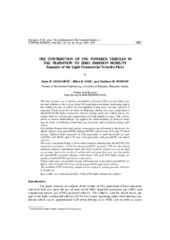Приказ основних података о документу
The contribution of cng powered vehicles in the transition to zero emission mobility example of the light commercial vehicles fleet
| dc.creator | Stanojević, Nada | |
| dc.creator | Vasić, Miloš | |
| dc.creator | Popović, Vladimir | |
| dc.date.accessioned | 2022-09-19T19:18:41Z | |
| dc.date.available | 2022-09-19T19:18:41Z | |
| dc.date.issued | 2021 | |
| dc.identifier.issn | 0354-9836 | |
| dc.identifier.uri | https://machinery.mas.bg.ac.rs/handle/123456789/3574 | |
| dc.description.abstract | The aim of paper was to discuss contribution of bi-fuel CNG powered light commercial vehicles to the well-to-wheel CO2 equivalent emissions, both today and in the coming decades in which the development of new fuels and new vehicles is expected. Field research was done in Belgrade, during one year, using Euro 5 diesel/LPG/CNG light commercial vehicles driving under low vehicle speed, low engine load, low exhaust gas temperature and high number of stops. The well-to-wheel as neutral methodology was applied for understanding of each fuel pathway in terms of reducing greenhouse gas emissions and increasing energy efficiency. Calculation showed that total energy consumption per kilometre is the lowest for diesel vehicles since petrol/LPG and petrol/CNG vehicles use 21% and 7% more energy. Tank-to-wheel emission of CO2 equivalent is most favorable for petrol/CNG with 28.8% and 6.7% less CO2 equivalent with petrol/LPG and diesel vehicles. The same conclusion brings well-to-wheel analysis showing that diesel/CNG CO2 equivalent emission is 13.5% less than petrol/LPG, apropos 1.5% less than diesel operated vehicles considered within this field research. Figures are not as high as previous, due to the results of well-to-tank emission, that were most favorable for petrol/LPG powered vehicles, with almost 51% and 32% better results regarding to petrol/CNG and diesel, respectively. Within same time, lowest fuel cost per kilometre was achieved by petrol/CNG vehicles, with 32% and 35% less cost than petrol/LPG and diesel vehicles. The available CNG technology should not be neglected, waiting for new solutions to be proven. | en |
| dc.publisher | Univerzitet u Beogradu - Institut za nuklearne nauke Vinča, Beograd | |
| dc.rights | openAccess | |
| dc.rights.uri | https://creativecommons.org/licenses/by-nc-nd/4.0/ | |
| dc.source | Thermal Science | |
| dc.subject | zero emission mobility | en |
| dc.subject | LPG | en |
| dc.subject | light commercial vehicles | en |
| dc.subject | CNG | en |
| dc.title | The contribution of cng powered vehicles in the transition to zero emission mobility example of the light commercial vehicles fleet | en |
| dc.type | article | |
| dc.rights.license | BY-NC-ND | |
| dc.citation.epage | 1878 | |
| dc.citation.issue | 3 | |
| dc.citation.other | 25(3): 1867-1878 | |
| dc.citation.rank | M23 | |
| dc.citation.spage | 1867 | |
| dc.citation.volume | 25 | |
| dc.identifier.doi | 10.2298/TSCI200721241S | |
| dc.identifier.fulltext | http://machinery.mas.bg.ac.rs/bitstream/id/2156/3571.pdf | |
| dc.identifier.scopus | 2-s2.0-85107694869 | |
| dc.identifier.wos | 000652180700018 | |
| dc.type.version | publishedVersion |


